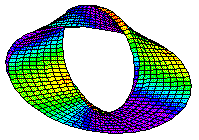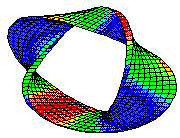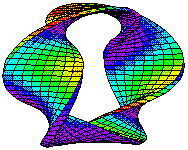Möbius Strip
Sphere has two sides. A bug may be trapped inside a spherical shape or crawl freely on its visible surface. A thin sheet of paper lying on a desk also has two sides. Pages in a book are usually numbered two per a sheet of paper. The first one-sided surface was discovered by A. F. Möbius (1790-1868) and bears his name: Möbius strip. Sometimes it's alternatively called a Möbius band. (In truth, the surface was described independently and earlier by two months by another German mathematician J. B. Listing.) The strip was immortalized by M. C. Escher (1898-1972).

To obtain a Möbius strip, start with a strip of paper. Twist one end 180o (half turn) and glue the ends together (the avi file takes 267264 bytes). For comparison, if you glue the ends without twisting the result would look like a cylinder or a ring depending on the width of the strip. Try cutting the strip along the middle line. People unacquainted with Topology seldom guess correctly what would be the outcome. It's also interesting to cut the strip 1/3 of the way to one edge. Try it.
I have put together a short (155648 bytes) avi movie of a twisting Möbius strip. (When you get to the movie page click on the frame to start the movie.)
Now once you know the trick, surely you would like to find other one-sided surfaces. Before gluing the ends together you can twist the strip twice or even three times. Do you get one-sided or two-sided surface?
 |  |  |
 |  |  |
P.S.
There is an additional page with an interactive Java illustration that lets one "see through" the strip in more than one sense. And, of course, there are other pages devoted to the Möbius strip available on Internet. One deserves a special mention. Richard Marsden (whose page has disappeared from the Web) managed to produce a VRML version of the strip. I enjoyed rotating the strip this way and that way. Do not know why but the following passage by Art Buchwald from the back cover of Ephraim Kishon's The Funniest Man in the World came to my mind:
Ephraim Kishon is the second funniest humorist I know... He is hilarious and I hate him.
How it's done
I shall only discuss here the Math that went into the Möbius strip creation movie.
It all starts with an observation I gleaned surfing MathSoft pages. For a fixed range of values of t, consider the curves
x(t) = Rsin(t/R), y(t) = R(1 - cos(t/R)),
parameterized by R. Each of them is a piece of the circle
x(t)2 + (y(t) - R)2 = R2.
For large R (and a fixed range of t's), such a piece is small relative to the size of the circles and, hence, looks nearly as a straight line segment. For small values of R (near 1), the piece is closer to a complete circle.
When the pieces are shown one at a time for a decreasing sequence of R's, the frames create an impression of a segment being folded into a circle. To generate the movie, I used 21 frames numbered 0 through 20, with the radius changing according to the formula
R(k) = 21 / (k + 1),
where k is a frame number.
Creating a Möbius strip is a 3-dimensional affair. Therefore, in addition to x (horizontal) and y (vertical) coordinates we also need a z coordinate. Think of that coordinate as directed perpendicular to the screen. For the initial segment, which is more like a piece of a straight line than a circular arc, I took z = const for the length of the segment. The segment becomes a rectangle - a "band" - to be folded into a Möbius strip. The rectangle has two sides: the original segment, which below is referred to as "the (xy) segment", and the perpendicular side, referred to as the "z segment."
As the (xy) segment folds into a circle, the z segment rotates in the (yz) plane. I have discussed rotation of a plane on my cycloids pages. One caveat is however in order. To create a Möbius strip, we have to twist the whole of the rectangle, not just its z ends. However, different portions of the rectangle should rotate at different speeds - the end rotating the fastest while the middle of the strip should not move at all. Thus I use the quantity
w = (t - tmiddle)2
as the angular velocity for the z segment at different points on the folded (xy) segment. The quantity is very nearly 0 for points close to the middle of the strip.
Lastly, the two ends of the strip should rotate in the opposite directions. So that additionally the rotation matrix had to be multiplied by
sign(t - tmiddle).
That's it. A very practical application of a little Trigonometry and Analytic Geometry. There is another creation movie, 303104 bytes. It shows the front view of the twisting strip.
A letter from Alexander Grässer describes further cutting (but now also pasting) activities. It's possible to glue together two bands of paper, be these cylinders or moebius strips. Even in the case of two cylinders the result will surprise most of the parents, not to mention their kids.
My logo is also a one-sided surface.
Reference
- S. Barr, Experiments In Topology, Dover Publications, NY, 1989
- R. Courant and H. Robbins, What is Mathematics?, Oxford University Press, 1996
- K. Devlin, Mathematics: The Science of Patterns, Scientific American Library, 1997
- D. Hilbert and S. Cohn-Vossen, Geometry and Imagination, Chelsea Publishing Co, NY 1990.
- C. A. Pickover, The Mobius Strip: Dr. August Mobius's Marvelous Band in Mathematics, Games, Literature, Art, Technology, and Cosmology, Thunder's Mouth Press, 2006
|Contact| |Front page| |Contents| |Did you know?| |Geometry|
Copyright © 1996-2018 Alexander Bogomolny
73509935
